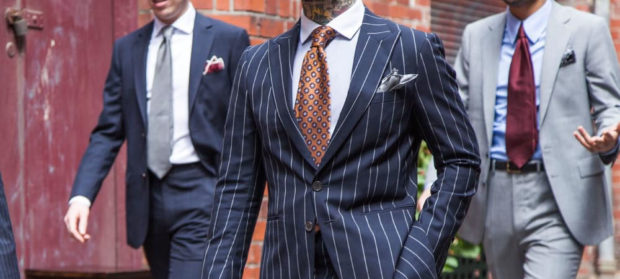A Gentleman’s Guide to Pocket Squares
When it comes to formal fashion for men, there’s one accessory that’s often neglected, misunderstood, and misused: the pocket square. Once a staple of men’s fashion, the masses seem to have forgotten about it. But you can be the exception. The key is to know when and how to wear these elegant symbols of class.


Types of Pocket Squares
The pocket square has been around for centuries. Some say it finds its origins in ancient Egypt, Rome, and Greece, where the wealthiest members of society used white linen squares as handkerchiefs. In the Middle Ages, upper-class individuals would infuse their handkerchiefs with fragrances and perfumes as a way of combatting the horrid smells of urban streets.
It wasn’t until the 19th century and the rise of the two-piece suit that the word “pocket square” was first used in popular culture. Around this time, men would commonly carry two handkerchiefs – one in their pocket (serving the role of a tissue) and another in their jacket pocket (as a fashion statement).
Today, the handkerchief is all but obsolete among younger generations of men. In fact, substituting one for the other is frowned upon. Any men’s fashion expert will warn you that the handkerchief and pocket square are two completely different items. Whereas a handkerchief is typically larger and made of cotton, a pocket square is much smaller and can be made of several fabrics – including silk, linen, and cotton. A handkerchief is primarily an item of utility – used for blowing your nose or wiping brow sweat – while a pocket square is strictly for decorative function.
In addition to different materials, pocket squares can be categorized by design. The most common styles include bandana, solid, patterned, and tipped. Four-panel pocket squares are also popular, as they allow you to layer colors when folded properly.
When to Wear a Pocket Square
Feel free to make your own fashion statement, but there are generally three scenarios in which men will wear pocket squares:
- When you want to make a boring or conservative suit a little more exciting.
- When you want to make a suit or blazer more formal. (Be sure to wear both a pocket square and a tie in this situation. It’s also helpful if you mismatch them. If you don’t feel confident enough to do this, a starch white pocket square goes with any tie in your wardrobe.)
- When you want to look semi-formal, but would prefer not to wear a tie. In many situations, a pocket square will suffice. (If it’s subtle and silk, it’ll make your suit instantly appear more expensive.)
Selecting the Right Pocket Square
In order for any outfit to look good, you have to be conscious of the colors and patterns you’re selecting. The main point of dressing well is to highlight your facial features. The pocket square provides an elegant opportunity to do so.
The pocket square’s role is complementary. It’s intended to enhance – not dominate. If you’re looking for a good rule of thumb for selecting the right colors, the classic color wheel is worth referencing.
- Primary colors like red, blue, and yellow are bright and attention-grabbing. They’re best used in contrast with darker backgrounds.
- Secondary colors like green, purple, and orange sit directly opposite the primary colors on the wheel and provide good contrast. If you’re feeling especially bold, you can pair a primary color with a secondary color on the opposite side of the color wheel.
- Tertiary colors are softer, easy-going colors that can be used in analogous color schemes when you want to group colors of the same family. They also go well when you want a conservative or subdued look that’s still classy and elegant.
Folding a Pocket Square
Telling someone how to fold a pocket square is like telling them how to paint a picture. While there are some technical elements, a lot of it has to do with personal preference, feel, and style.
Cotton pocket squares are thicker and tend to maintain their form over long periods of time. Silk pocket squares are more delicate. So while they won’t cause your coat pocket to puff up, they may lose their form over the course of an evening.
There are numerous ways to fold a pocket square – including a flat, one-point, two-point, three-point, four-point, puff, winged-puff, and presidential. Spend some time studying and practicing different folds to increase the versatility of the pocket square in your wardrobe.